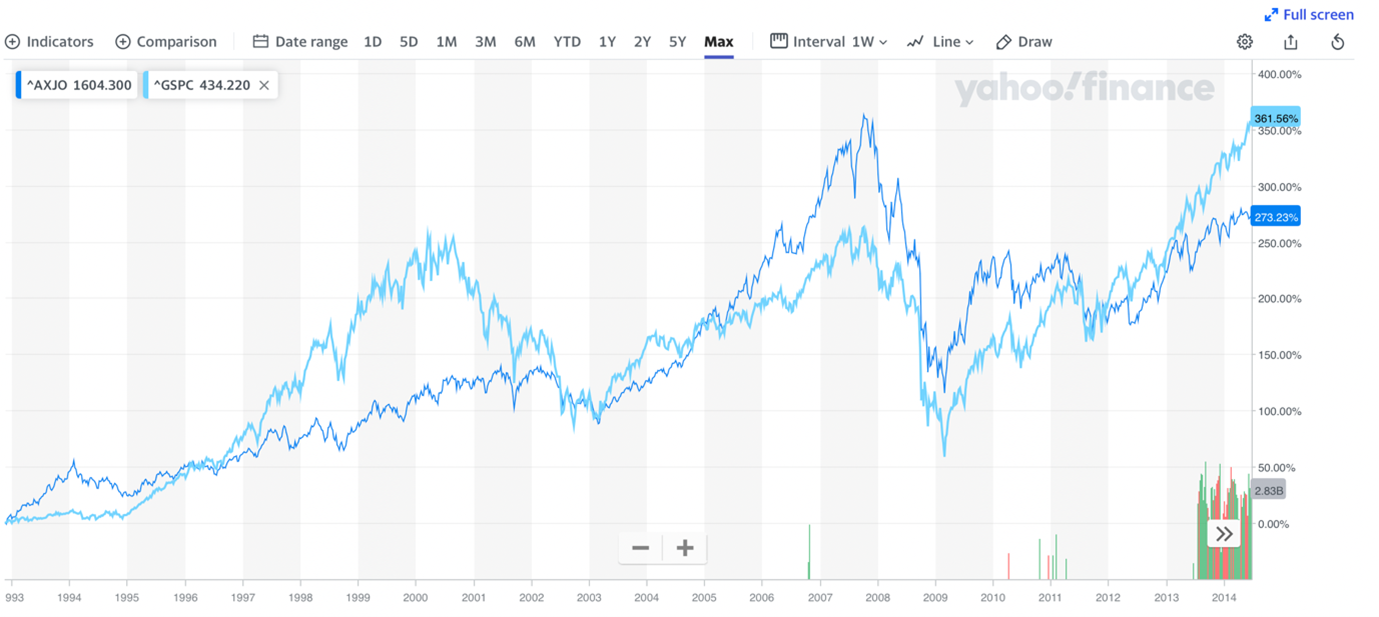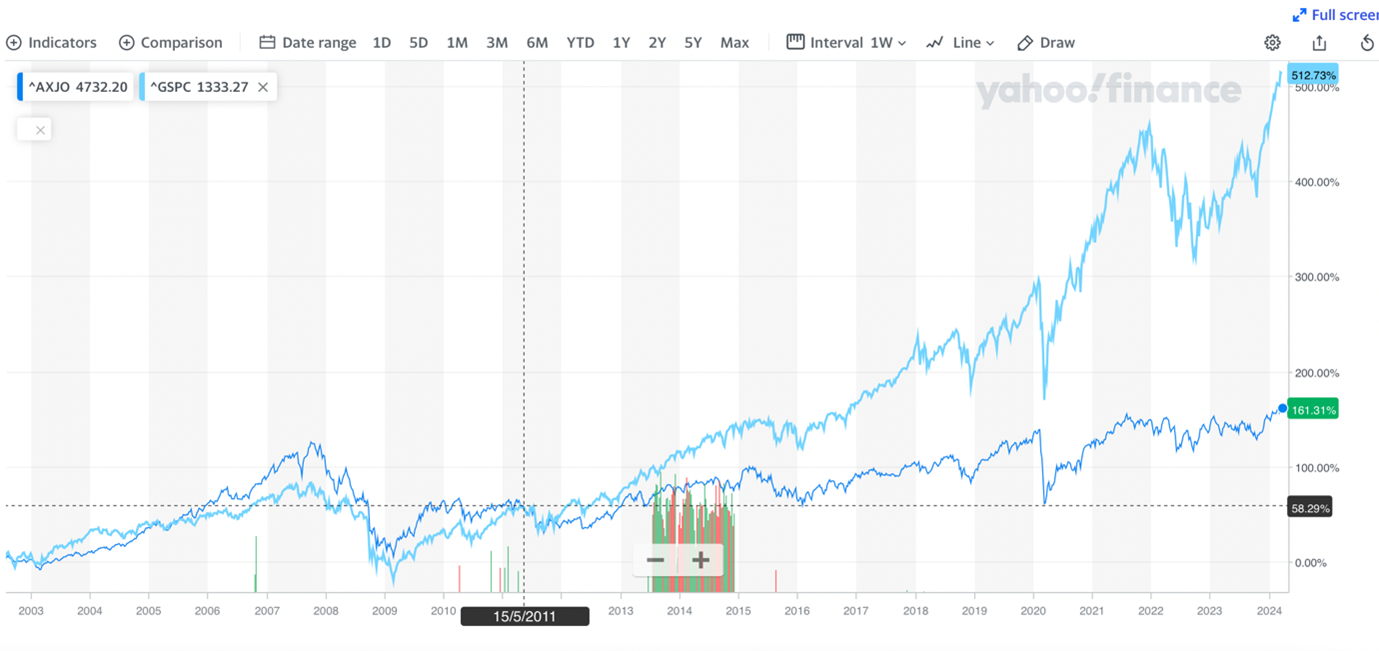

Keep the number 5500 in your head as a positive sign for stocks in 2024. The number is the call for the biggest bull on Wall Street, who has guessed that this is where the best measure of the US stock market, the S&P 500 index, will end up going to.
In case you’re wondering, if John Stoltzfus of investment bank Oppenheimer & Co. is right, we’re talking about a 5% gain ahead, on top of the 10.19% this index has gone up since the start of this year. Stoltzfus is talking about 15% for 2024 on top of the 24% gain the index did in 2023.
Now you don’t need to be Warren Buffett to know the movements of the US stock market have a big bearing on our market, so am I suggesting that we might only see a 5% gain here this year? Well, given we’re up only 2.4% this year and we were up only 7.8% last year.
So, is it likely that we’ll have another disappointing year compared to the Yanks, when it comes to share price rises? I suspect not, but let’s see what the relationship is between the US market index, the S&P 500 and our S&P/ASX 200.
To show whether we always play ‘follow the leader’ with Wall Street, I’ve used the comparison function on the au.finance.yahoo.com website. The light blue line is the S&P500 index since 1993 and the dark blue line tracks our index.
S&P 500 vs S&P/ASX 200

Source: au.finance.yahoo.com
What you notice is that both markets move in the same direction over time but there can be periods where, for example, the US market roars ahead, as it did with the dotcom boom in 1996 to 2000. However, as the US market crashed in 2000 to 2002, we kept rising until 2002 but both rallies resumed in 2003.
And again, both markets rose at different rates, with our market outperforming the US market because of the China boom and the mining boom it gave us, while many US companies were still licking their wounds from the dotcom crash.
Then from 2009 to 2011, we outperformed the US market because the GFC didn’t even put us into a technical recession, while the Americans copped what they labelled The Great Recession. Why? Their banks were involved in crazy financial products that our banks had little exposure to, and China was still growing strongly.
After 2011, the US market zoomed ahead because of the spectacular tech boom. While our market index went higher, it was at a slower rate. The chart below looks at the big gains since 2012 for US stocks.
S&P 500 v S&P/ASX 200

This chart shows why the US market could have a pullback and grow more slowly, while we have potential to play a bit of catch up.
Of course, a lot of this big US market gain has come from the sensational tech companies — Alphabet, Amazon, Apple, Meta, Microsoft, Nvidia, and Tesla — that are not only dominant market players, they’re also in the forefront of the Artificial Intelligence (AI) revolution. This could prove to be overplayed and could cause a sell-off down the track.
On the other hand, our market is bound to ride higher as China starts to grow more strongly, the world economy rebounds as interest rates fall and the global support for electric vehicles helps lithium prices rise.
At the start of the year, CommSec’s chief economist, Craig James speculated that the ASX 200 would lift to a 7300-7600 range by June 30.
It’s now 7811! AMP’s Shane Oliver tipped the market would end at 7900 by the conclusion of 2024 but given there are bound to be tailwinds for stock prices, I’m expecting the index should top 8000.
Why? Here are 5 reasons:
On that point, I like this research work from Chris Katje on Nasdaq.com that reveals this: “Over the last 16 presidential election years, the S&P 500 has been up 14 of the full years, according to the website Barchart. The two presidential election years in the last 60-plus years that saw the S&P 500 down were the global financial crisis and the dot-com bubble.”
1960: +0.5%, Kennedy (D) elected
1964: +16.5%, Johnson (D) elected
1968: +11.1%, Nixon (R) elected
1972: +19.0%, Nixon (R) elected
1976: +23.8%, Carter (D) elected
1980: +32.4%, Reagan (R) elected
1984: +6.3%, Reagan (R) elected
1988: +16.8%, Bush H.W. (R) elected
1992: +7.7%, Clinton (D) elected
1996: +23.1%, Clinton (D) elected
2000: -9.1%, Bush W. (R) elected
2004: +10.9%, Bush W. (R) elected
2008: -37.0%, Obama (D) elected
2012: +16.0%, Obama (D) elected
2016: +12.0%, Trump (R) elected
2020: +18.4%, Biden (D) elected
Importantly, Katje points out that “…the average return of the S&P 500 in the presidential election years shown above is 10.5% [but after] stripping out the global financial crisis and the dot-com bubble, the S&P 500 gained an average of 15.3%!”
I rest my case for share market optimism in 2024. And as super returns rest heavily on stock market performance, this should be a good year for stocks and super returns too.
So, if the US market breaks 5500, my tip for the local market should be on the money.